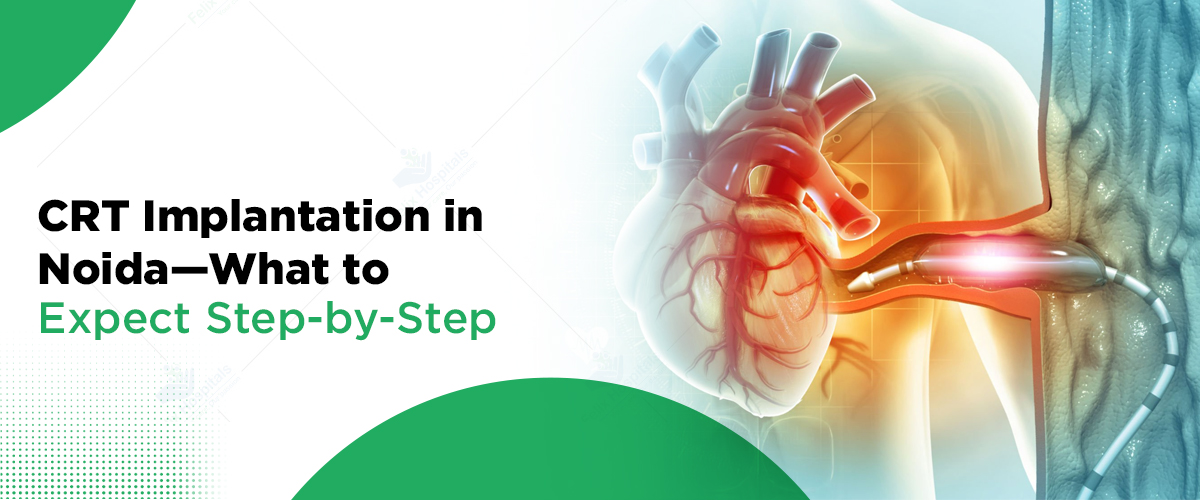
Subscribe to our

Cardiac Resynchronization Therapy (CRT), or biventricular pacing, is a type of procedure in which a pacemaker of a unique kind is implanted that synchronizes the two sides of your heart to beat. This procedure can improve the quality of life in patients with heart failure by improving the heart's ability to pump blood effectively.
If you are facing heart-related problems, you need to take proper care. Firstly, look for the best cardiology hospital near your area to receive timely and effective treatment.
Take the first step toward better heart function. Locate a top-rated cardiologist or specialized heart hospital in your area now. Call us today at +91 9667064100.
CRT is used to repair the timing of heart contractions, especially of the ventricles—the lower heart chambers. Ventricles contract asynchronously in most heart failure patients, and the heart is then not able to easily pump out blood. CRT is an attempt to break through this by returning to synchronized contraction through a biventricular pacemaker.
A CRT device differs slightly from an ordinary pacemaker:
Whereas CRT is aimed at resynchronization of heartbeats, an Implantable Cardioverter-Defibrillator (ICD) is used to treat potentially life-threatening arrhythmias of the heart (ventricular tachycardia or fibrillation). A CRT-D device—a biventricular pacemaker with an ICD—is needed in some patients for full treatment.
CRT is generally prescribed for patients with heart problems (arrhythmias or poor functioning heart). Some common reasons that often lead to the development of this condition are:
Almost 20%–30% of heart failure patients experience incoordinate ventricular contractions. It aggravates their symptoms and overall heart function. In a final measure when drugs and lifestyle changes no longer work, CRT is an essential next step to enhance heart function.
Cardiac Resynchronization Therapy is a widely established and extensively applied procedure. As many as 311,000 patients in the United States alone were implanted with CRT devices during the period 2006 through 2012—a testament to its efficacy to manage heart failure symptoms.
There are several benefits of CRT that can greatly impact your life:
As in any medical procedure, CRT does have some risks, although extremely rare severe ones. Some possible complications include:
Your cardiologist will explain all these risks with you before proceeding and will try everything to prevent them.
Here at Felix Hospital, our staff of experienced cardiologists accumulates decades of experience and unparalleled expertise in sophisticated heart procedures, such as Cardiac Resynchronization Therapy (CRT). Regardless of whether you're experiencing heart failure or rhythm disorders, our professionals are prepared to provide the most precise and empathetic care:
Balanced with clinical aptitude and nurturing hearts, cardiac specialists at Felix Hospital provide personalized, safe, and effective CRT implantation—renewing you to an improved, healthier heartbeat.
Don't wait until your symptoms are severe—see a heart specialist to find out if CRT could help your heart.
If you have heart failure or abnormal heart rhythms and drugs do not work, Cardiac Resynchronization Therapy can be lifesaving. Consult a capable cardiologist to assess your condition and see if you are a candidate.
Your heart needs the best care—do not wait to search for the best cardiologist or heart center in your town and take affirmative steps towards a better life. If you wanted to know about the cost at the best hospital in Noida, The Felix Hospitals are always here for you in any positive or negative situation for your healthier and happier heart life.
Q- How long does a CRT device last before it needs replacement?
Ans- A CRT device typically lasts 5 to 7 years, depending on the usage and battery life. Your cardiologist will monitor the device regularly to determine when a replacement is needed.
Q- Can I live a normal life after getting a CRT device?
Ans- Yes, most patients experience improved quality of life, including better physical endurance and fewer symptoms of heart failure. However, some lifestyle adjustments may be necessary.
Q- Are there any restrictions on using electronic devices after CRT implantation?
Ans- While most everyday electronics are safe, it's best to avoid close or prolonged contact with strong magnetic fields or industrial equipment. Always consult your device manual and cardiologist.
Q- What signs indicate that my CRT device is not working properly?
Ans- Symptoms such as recurring fatigue, dizziness, or shortness of breath may suggest the device isn’t functioning optimally. Regular follow-ups and remote monitoring help catch issues early.
Q- Is CRT effective for all heart failure patients?
Ans- No, CRT is most effective for patients with specific electrical conduction delays (like left bundle branch block) and reduced ejection fraction. A detailed evaluation is required to confirm eligibility.
Q- Can I undergo MRI scans after having a CRT device implanted?
Ans- Many modern CRT devices are MRI-compatible, but this depends on the device model. Always inform your healthcare provider and MRI technician beforehand.
Q- What kind of follow-up care is needed after CRT implantation?
Ans- Follow-ups usually include regular ECGs, chest X-rays, and device interrogations to ensure the CRT is working correctly and to adjust settings as needed.